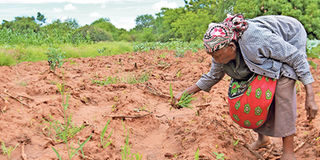Native vegetables make a comeback

Damaris Mariamu harvests dandelion leaves on her farm in Makueni. A kilogramme of dandelion costs between Sh15 and Sh20 at the farm while the same quantity can go for Sh50 or as high as Sh80 during the dry season when supply drops. PHOTO | PIUS MAUNDU | NATION MEDIA GROUP
What you need to know:
- Traders say most customers are young women keen on their diets. They usually buy more than one type of vegetable
- Dandelion grows on its own on cultivated land. Locals and Ms Maundu’s neighbours say they find the leaves too bitter to be eaten.
- Scientists and food experts say dandelion can help prevent a variety of lifestyle diseases. Ms Maundu and a handful of traders buy dandelion leaves from their neighbours and deliver them to Maungu and Voi markets.
- Tonnes of indigenous vegetables, which come mostly from Kisii, Bomet and Narok counties, are also delivered to markets in Nairobi every morning.
Tucked in the heart of Kyanginywa near Kibwezi town in Makueni County is Kanini Maundu’s farm. The maize and bean crops stand majestically by a pesky weed: dandelion.
Ms Maundu is among scores of farmers in the semi-arid region who spare dandelion as they weed their lands.
They instead harvest the leaves of the weed twice a week for sale in Kilifi, Kwale, Mombasa and Taita-Taveta counties, where it is a priced vegetable.
She was harvesting the weed at a neighbour’s farm when the Seeds of Gold team paid her a visit.
“Work usually starts early in the morning. We encourage local farmers to spare dandelion as they weed their lands,” the 42-year-old said during a guided tour of her farm. “We encourage farmers to harvest dandelion leaves themselves and deliver them to us for pay.”
“Those unable to harvest for one reason or another usually allow us to. Local farmers are happy to earn from plants they would have thrown away.”
Dandelion grows on its own on cultivated land. Locals and Ms Maundu’s neighbours say they find the leaves too bitter to be eaten.
Before they began selling the leaves as vegetables, they used them as rabbit feed. Others crush the leaves and make a concoction they use to treat multiple chicken diseases.
Dandelion is in a class of African indigenous vegetables billed as superfood. They include cow peas, spider plant (saga), mchicha, vine spinach (nderema) and managu.
Scientists and food experts say dandelion can help prevent a variety of lifestyle diseases. Ms Maundu and a handful of traders buy dandelion leaves from their neighbours and deliver them to Maungu and Voi markets.
“A kilogramme of dandelion costs between Sh15 and Sh20 at the farm while the same quantity can go for Sh50 or as high as Sh80 during the dry season when supply drops,” Ms Maundu said.
CHANGING 'POOR MAN'S FOOD' PERCEPTION
“The money goes towards educating my children, buying food and other needs for my family.” She collects the dandelion leaves, washes them and packs them in sacks ready for the market.
The traders take the sacks of leaves to the road and flag down lorries heading to the Coast. On most occasions, the dandelion businesspeople travel at night so as to arrive at their preferred markets at dawn.
Tonnes of indigenous vegetables, which come mostly from Kisii, Bomet and Narok counties, are also delivered to markets in Nairobi every morning.
Individual farmers sell the vegetables to middlemen who then transport them on Nairobi-bound buses and trucks.
Vendors then distribute them to different parts of the city and neighbouring Kajiado, Kiambu and Machakos counties.
At a street behind St Peter Clavers Catholic Church in downtown Nairobi, hundreds of small and large scale traders sell indigenous vegetables. Callen Kemunto has sold indigenous vegetables at a stall in the ever busy area for 18 years.
“Many of our customers are young women keen on their diet and body shape. They rarely buy one variety of the vegetables. We advise them to get at least two. Managu is the most preferred traditional vegetable,” Kemunto told Seeds of Gold last week.
Osir Otteng, a lover of dandelion and spider plant, has seen his favourite vegetables flourish and go into decline – marginalised through long held stereotypes.
The corporate communication manager at South Eastern Kenya University is happy to see the vegetables making a comeback at dinner and lunch tables across the country, particularly in Nairobi and other urban centres.
“Dandelion and saga are readily available at most Nairobi supermarkets. I am glad because the perception that traditional vegetables are a poor man’s food is changing rapidly,” he said.
Dr Abel Otieno, an agribusiness lecturer at Jaramogi Oginga Odinga University of Science and Technology in Bondo, Siaya County says more and more Kenyans are changing their attitudes towards indigenous food.
INTENSIVE MARKETING
The change is as a result of intensive marketing by government authorities, non-governmental organisation players, nutritionists and health experts.
Most of the vegetables are readily available, making them grow in popularity. Indigenous vegetables are highly sought because they are a rich source of vitamins and minerals.
However, the biggest challenge in tapping into the potentially huge African indigenous vegetables market is the low production.
“Most of the traditional vegetable varieties only sprout when it begins raining. The rest are grown by smallholder farmers, mainly for domestic consumption,” Dr Otieno said.
“That is why the supply of the vegetables has not matched the demand in high margin markets among consumers in Nairobi, Mombasa, Kisumu, Nakuru and other large towns.”
He urges more Kenyans to tap into the popularity of the indigenous vegetables by growing them even in their backyards.
Traders dealing in indigenous vegetables cite lack of specialised storage facilities at the markets as a major impediment in the business.
“It means we must discard the stocks not sold or give them to restaurants at throw-away prices,” Ms Maundu said, calling on national and county governments to come to the traders’ rescue.





